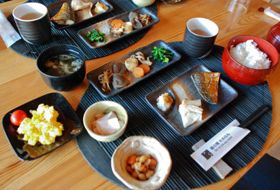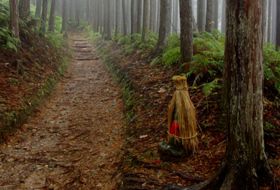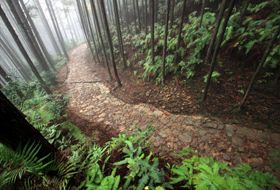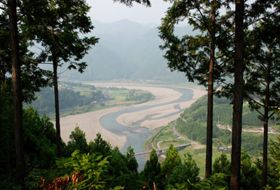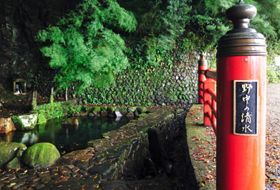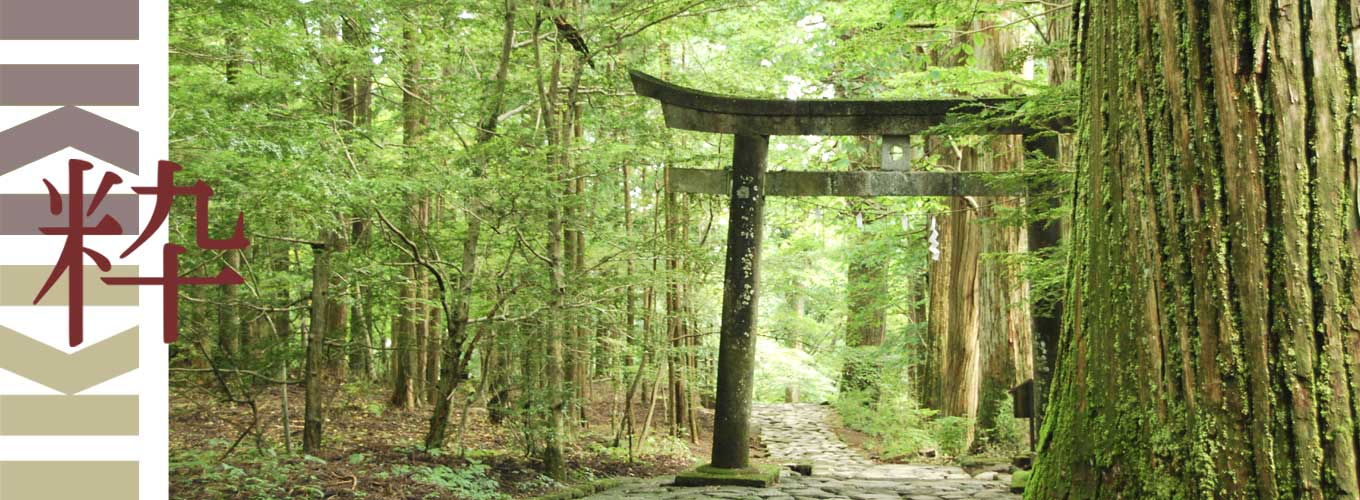
6 days hiking the Kumano Kodo in Japan
A network of pilgrimage routes runs across the Kumano area, south of Osaka. The trail goes through a dense forest. A big part of the charm of the whole experience is staying at a small traditional Japanese inn in the village and close to the hot springs. A relaxing bath in an onsen is the perfect way to end an active hiking day. This module takes you to the most important and sacred Shinto shrine in Japan.
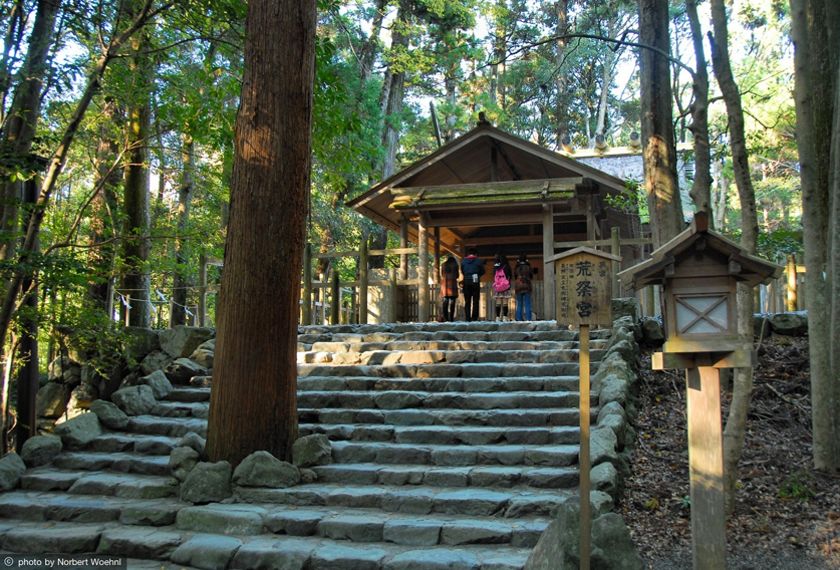
6 day hike from the coast straight through the mountains to Ise
The walking trail leading through stunning nature starts in Takajiri, several hundreds of kilometers south of Kyoto and Osaka. You will stay at a minshuku, a family-run Japanese style bed & breakfast. You will not only be served breakfast but dinner as well. The last night you spend in Ise, a small town that houses the most important Shinto shrine in Japan. There’s a handy luggage-forwarding service available, so no need to carry your luggage. Basically, a local will drive your luggage to your next accommodation, whilst you hike un-burdened. The perfect blend of absolutely stunning nature and almost mystic temples and shrines make this pilgrimage well worth the effort.
Along Kumano’s sacred sites to the Grand shrines of Ise
The Kumano Kodo is a series of ancient pilgrimage routes that cross over the Kii Peninsula, down south of Osaka. It’s easy to see why the Kumano Kodo has been recognised as a World Heritage site by Unesco since 2004. The Kumano area with its stunning mountains, rugged coast line, giant old trees, abundance of waterfalls and rivers, has been considered a sacred site since prehistoric times and has been associated with nature worship. On the Kii Peninsula there are several important sacred sites with Buddhist, as well as Shinto shrines. These sacred spots were considered to be the abode of the Gods.
Day 1 – Trace the steps of the emperors
The first section is a portion of the Nakahechi, also called the Imperial route. It was favoured by the imperial family back in the day, so you’ll be following in the footsteps of royalty. The earliest records of this route dates from the early 10th century. Since those days the imperial family would make the pilgrimage from Kyoto. On the first day you will walk from Takijiri-oji to Takahara (4 kilometers). This route takes you to Kumano-jinja, one of the sacred sites on the Nakahechi. Here you can see giant camphor trees and from the village you get stunning views on the Hatenashi mountain range. The entire hike features many unpaved trails. You will stay the night at a minshuku in the village, where the food served is delicious. Relaxing and reminiscing about your experiences in soothing onsen bath is a perfect way to finish a day of exploring.
Day 2 – Centuries-old cedar trees and a famous spring
Today you hike from Takahara to Nonaka. The hike is 13 kilometers long and takes around 5 hours (without stops). On the Hashiori-pass, you will see a small statue of Kazan. Kazan was one of the first emperors who made the pilgrimage, although he travelled by horse and by cow and not on foot. Just like you, he probably walked by Tsugizakura-oji, one of the most ancient sacred sites on the route. The shrine is surrounded by 800 year old cedar trees, a lovely place to enjoy the packed lunch box prepared by your minshuku. Towards the end of your journey, you can rest at the Nonaka-no-Shimizu hot spring. You will spend the night again at a traditional minshuku where you will be pampered with a delicious dinner made with local and seasonal ingredients.
Day 3 – Stay at Japanese inns
Today is the day you’ll have to get up early, as the 20 kilometers walk might take the entire day. The route takes you across many passes towards the Grand shrine of Iwagami-oji, the highest point on this route. Further along the way, you’ll bump into the statue of Jagata Jizo. He is the protector of travelers and the weak (woman and children). He will for sure give you a halfway boost.
The route takes you along forest trails through mountain-top villages and past pretty awesome lookout spots. After a long descent past paddy fields and tea plantations you finally arrive at Kumano Hongu Taisha, the final destination of your trip. The site of this Shinto shrine is surrounded by giant cedar and cypress trees. The use of unfinished material allows the pavilions to blend in beautifully into the natural environment. It almost seems as if they’re rising up from sacred ground. Intricate joint works were used instead of nails. Over the centuries the pavilions were partially destroyed by periodic fires and flooding, but always faithfully rebuilt to their original state. You will stay the night in Yunomine Onsen, a village of traditional minshuku with hot springs, hidden in a narrow valley amidst the rugged mountains. The hot springs were discovered 1800 years back and many pilgrims perform purification rituals in the hot spring waters as part of the pilgrimage traditions. Many pilgrims spend more than one night here.
Day 4 – The place where gods descended
Today you travel by bus from Yunomine Onsen to Gongen-mae, where the Kumano Hayatama Taisha, the second of the three sacred Kumano Grand shrines, is situated. The Kamikura-Jinja is a shrine that can be reached by climbing 500 steep stone steps. At the top of the steps is a huge sacred rock, called Gotobiki-Iwa, from which it that is said that the Kumano gods first descended to earth. It is believed that next they went down the steep stone staircase and spread out. The shrine has the best view of the entire Shingu area and it’s a great spot to enjoy a lunch box, available at one of the small shops nearby.
Before leaving Shingu, you can quickly visit Ukishima-no Mori Island in the residential area of Shingu. Ukishima-no Mor is a 5000 square meter floating, swamp forest, where there are more than hundred amphibious plants that have adapted to survive in both cold and warm climates. Every step feels like the floor is moving, this is because it’s literally floating.
From Shingu railway station there are trains to Katsuura, where you’ll stay the night. Katsuura is in essence a coastal fishing port turned into a hot spring resort, an excellent place to get familiar with Japan’s popular bathing culture. There are multiple hot spring baths located throughout the village and almost certainly located in hotels and ryokan, but most are also available for day use. There is no better place to relax and unwind than in a hot bath after a memorable trek. You can spend the night in a hotel or one of the ryokan.
Day 5 – Beautiful train journey along the coast
Today you travel from Katsuura to Ise town. The journey by train takes you along the rugged east coast of Kii Peninsula. The city is home to the most sacred Shinto shrines in Japan: the Inner shrine, (Naiku) and the Outer shrine (Geku). The Inner shrine enshrines Shinto’s most venerated deity, the Sun Goddess (Amaterasu Omikami) and is believed to have been established over 2000 years ago. The main buildings are built in the original architectural style and show no influences from the outside. Both, the Inner and Outer shrine, are rebuilt every 20 years from scratch according to an ancient Shinto tradition. Both are constructed using plain Japanese cypress wood. When you walk through this area it feels like you are traveling through time: the simple gravel-covered paths, wooden shrine structures and the peace and quiet of the forest. The main hall is surrounded by multiple fences. You can get quite close to the inner shrine but visitors are only allowed to pass the outermost fence where photography is not allowed. You will spend the night in Ise.
Day 6 – The Ise shrine, Japan’s most important Shinto shrine
The traditional way to the Inner shrine of Ise is a nearly one kilometer long street, lined by many traditional style buildings, souvenir shops and restaurants. Among the regional specialties available here are akafuku (“red happiness”), a Japanese sweet made of mochi rice paste and red bean paste, and Ise Udon, thick udon noodles in a thicker than usual sauce. This is also a great place to try some fresh oysters, straight out of the sea.
On your way back to the centre you can visit Geku, the Outer shrine, where you will find the goddess and guardian of food, housing and clothing. At the entrance of the shrine grounds you will find the Sengukan Museum that explains the monumental shrine rebuilding process to the visitors. It exhibits a replica of the Inner shrine and the main sanctuary. From Ise you can continue your journey through Japan.
The price for this 6 day hike is €825,– per person based on double occupancy.
Prices may vary, depending on the day (weekend) or travel season.
What’s included in the price:
– Three nights’ accommodation in traditional minshuku
– Two nights in Western-style hotels in Katsuura and Ise
– 5x breakfast, 3x dinner and 2x lunch
– Instructions and info pack
– Luggage transfer
– Train ticket from Katsuura to Ise
What’s not included
– Transportation by local bus
– Guide services and/or entrance fees
– All other meals
Back to iki Tours Japan
